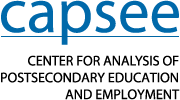CAPSEE at the Association for Education Finance and Policy (AEFP) 39th Annual Conference
Conference: Association for Education Finance and Policy (AEFP) Annual Conference
Date: March 13–15, 2014
Several CAPSEE researchers presented research findings at the 2014 AEFP conference.
Linking College and Labor Market Datasets for Research on the Labor Market Returns to College
Date: March 13, 2014, 7:30–10:00 AM
This workshop provided a practical overview of methods to link college transcript records to labor market data. Such datasets allow for longitudinal analysis of all college students within a state or system as they progress through college and enter the labor market.
Participant
Di Xu, CCRC and CAPSEE
Estimating the Impact of Online Education on Labor-Market Outcomes
Date: March 13, 2014, 10:15–11:45 AM
This presentation described the first evidence on the effect of online education on labor market outcomes. The analysis uses administrative data on individuals who enrolled in a statewide community college system paired with unemployment insurance records from the state. Together, these data track the educational attainment and earnings of over 100,000 first-time college students.
Participant
Francie Streich, University of Michigan and CAPSEE
Work-Study Employment and Student Outcomes: A Propensity Score Analysis of Heterogeneous Effects
Date: March 14, 2014, 8:00–9:30 AM
This presentation described findings from research that estimates the effect of the Federal Work Study (FWS) program on academic and labor market outcomes, providing a new conceptual framework for understanding heterogeneity in FWS program effects. The research employs propensity score analysis with two waves of the nationally representative Beginning Postsecondary Student (BPS) survey to match FWS participants against two separate counterfactuals: other working students and non-working students.
Participant
Veronica Minaya, CCRC and CAPSEE
The Causal Effect of Federal Work-Study on Student Outcomes in the Ohio Public University System
Date: March 14, 2014, 8:00–9:30 AM
This presentation described research that estimates the causal effect of participating in federal work-study on college students’ academic outcomes in Ohio, including college GPA, credits earned, and persistence. The research employs a differences-in-differences instrumental variables model, which exploits the variation in allocation of federal work-study funds across institutions and across students.
Participants
Adela Soliz, Harvard University and CAPSEE
Bridget Long, Harvard University and CAPSEE
The Returns to Course Credits, Certificates, and Degrees: Evidence From Michigan’s Community Colleges
Date: March 14, 2014, 1:15–2:45 PM
Using administrative data from Michigan, this presentation described research to create estimates of the economic returns to a community college reward that tests violations of common assumptions and compares estimates from pooled OLS, fixed effects, and an efficient influence function estimator (EIF) similar to inverse probability weighting. The research estimates returns both at various quantiles of the earnings distribution and by field of study.
Participant
Daniel Kreisman, University of Michigan and CAPSEE
Satisfactory Academic Progress Requirements: Pell Grant Loss Prevalence and Impact on Student Outcomes
Date: March 14, 2014, 1:15–2:45 PM
This presentation examined research on how Satisfactory Academic Progress (SAP) standards affect Pell receipt, student enrollment behavior, and student outcomes. The presenters used term-by-term measures of Pell status, student grades, and attempted and earned credits to determine what proportion of students from a statewide community college system fail to meet SAP requirements and how this influences student outcomes.
Participant
Lauren Schudde, CCRC and CAPSEE
The Market Entry Strategies of For-Profit Colleges: Evidence From IPEDS
Date: March 14, 2014, 3:00–4:30 PM
The research presented examines for-profit enrollment growth between 2000 and 2010 and asks whether this growth is crowding out enrollment at community colleges. Using IPEDS data from 2000 to 2010 merged with data from the Census, the American Community Survey, the Grapevine survey, as well as yearly maximum Pell grant amounts, the presenters described enrollment trends around two policy shocks. In order to know how best to regulate the for-profits colleges, policymakers must have a better understanding of the strategies that govern their decisions to enter a market.
Participants
Adela Soliz, Harvard University and CAPSEE
David Deming, Harvard University and CAPSEE
Examining Wage Trajectories of Community College Students Using a Growth Curve Modeling Approach
Date: March 14, 2014, 4:45–6:15 PM
This poster session described research that examines the wage trajectories of Virginia community college students, using unit record transcript data from all 23 community colleges matched with quarterly Unemployment Insurance records from several states.
Participant
Di Xu, CCRC and CAPSEE
Career Technical Education and Labor Market Outcomes: Evidence from California Community College
Date: March 14, 2014, 1:15–2:15 PM
This presentation investigated the returns to sub-baccalaureate certificates and degrees in career technical (vocational) fields among those enrolled at California community colleges.
Participant
Ann Stevens, University of California, Davis, and CAPSEE
